Theme Parks & Themed Entertainment
Ruminations
Back from the Silver State, Roger found a few tidbits to share about a place in the middle of nowhere…

A trip east of Reno takes one along Interstate 80 to Salt Lake City and beyond. Contrary to common belief, the terrain is not all alkali desert with the somewhat occasional clump of sagebrush. That’s not to say you won’t find places like that, but there is a fair amount of water and greenery along the way as well.
For much of the trip, the highway parallels the former Central (then Southern and now Union) Pacific Railroad. That route followed an easy grade along an emigrant trail which made use of the terrain as it followed the water level of the Humboldt River west across the state. Trains still make the same journey today crossing the river back and forth in a number of places. Folks coming west along this route did so from the earliest days of the California Gold Rush. Even the infamous Donner Party traveled along the Humboldt.
It was not an easy trip to make, by any stretch of the imagination. Whether on horseback or in a wagon pulled by your trusty oxen, folks were extremely lucky if they could cover ten miles in a day. Today, that distance is covered in about seven minutes over on the Interstate by hordes of autos and trucks (especially the dreaded triples — trucks hauling three trailers at speed). If you managed to survive the journey, you got a real bonus as the river completely disappears into what is called the Humboldt Sink. It’s a great mass of mud and swamp that gives way to forty odd miles of desert terrain with an eventual arrival along the shores of the Carson River.
Folks encountering this unforeseen obstacle often abandoned all but the essentials of their possessions here. It’s not uncommon today for archeological teams to come here to practice their digging skills. Finds of all kinds reveal just how much people like you and I brought west to start a new life. In the earliest days of emigrant travel through here, with the prospect of little or no water ahead, it often came down to leaving everything behind with only the food and water you could carry for yourself and your livestock. Unfortunately, there were more than a few of these people who did not survive the journey along the Humboldt. Many were buried in simple graves next to the place where the party would have made camp for a night.
One of those was a woman named Lucinda Parker Duncan. Now depending on who tells this story, it is a tragic tale of life ending in the bleak Nevada territory. If this was a tale from Reader’s Digest, the condensed version of the story has her passing away, on August 15, 1863, after her party crossed the Humboldt at Gravelly Ford, just east of what is today the small community of Beowawe. (That is pronounced Bay-o-wah’-wee and is an Indian word meaning “gate” — so named for the peculiar shape of the hills close to town which gives the effect of a gateway opening to the valley beyond.) The emigrant trail took a hard climb over those hills to bypass the route of the river through the impressive and foreboding Palisade Canyon.
The Central Pacific graded its line through the area in 1868, with rails laid in place soon after. When trains began to carry passengers through the area in 1869, the railroad and the Pullman Company produced guidebooks for passengers to describe the history and highlights of the Overland Route. Among the many items mentioned was “The Maiden’s Grave”.
From the “Trans-Continental” — Published Daily on the Pullman Hotel Express Between Boston and San Francisco, Promontory Point, Utah, Monday, June 17, 1870:
” The Maiden’s Grave.
The Trans-Continental Guide in describing the early history of the country near the Palisades, about 435 miles from Sacramento, which we passed yesterday, narrates the following:
“In the early times spoken of, a party of emigrants from Missouri were encamped here, waiting for the water to subside. Among them were many families, women and children, who were accompanying their protectors to the land of gold. While here, the daughter of the train-master, an estimable young lady of 18 years, fell sick and despite the watchful care and loving tenderness of friends and kindred, her pure spirit floated into that unknown mist which enwraps the earth, dividing the real from the ideal, the mortal from the immortal. Her friends reared a humble head-board to her memory, and in the course of time — among the new life opening to them on the Pacific slope — the young girl’s fate and grave were alike forgotten by all but her immediate relatives. When the advance guard of the Central railroad — the graders and culvert men — came to Gravelly Ford, they found the lone grave and the fast decaying head-board. The sight awoke the finer feelings of their nature and aroused their sympathies, for they were men, these brown, toil-stained laborers. The ‘culvert men’ (masons) concluded that it was not consistent with Christian usage to leave a grave exposed and undefended from the incursion of beasts of prey. With such men, to think was to act, and in a few days the lone grave was enclosed with a solid wall, and a cross — the sacred emblem of immortality — took the place of the old head-board. In the day when the final reckoning between these men and the recording angel is adjusted, we think they will find a credit for that deed will offset many little debits in the ledger of good and evil. Perhaps a fair spirit above may smile a blessing on their lives in recompense of the noble deed. Bare the head reverently in passing this grave — not alone in honor of her who is buried here, but also in honor of that higher spirit of humanity which recognizes in a stranger’s grave an object too sacred to be passed lightly by, and pays to it tribute of respect due the last resting place of the dead.”
As Lucius Beebe and Charles Clegg added in their book, “The Central Pacific and Southern Pacific Railroads”: “The day after the story of “The Maiden’s Grave” appeared in the train newspaper, the cars paused to permit passengers to view the actual scene of this local folk legend, thus affirming the timely quality and enterprising character of the daily press.”
In 1879, the Central Pacific noted this information in its lineside guide:
“BEOWAWE (556 miles from San Francisco, elevation 4,695 feet)
It has a hotel, a few dwellings, and is the station where the business of the Cortez Mining District is transacted. There is no regular stage line, but private conveyances may be obtained.
The Maiden’s Grave
On a low point of land that juts out toward the river on the south side of the track is the Maiden’s Grave. Tradition has it that she was one of a party of emigrants from Missouri, and while they were in camp, she sickened and died.
Her loving friends laid her away to rest in a grave in plain site of the valley for miles in either direction. But while her remains were crumbling into dust, the railroad builders came along, and found the low mound, and the decayed head-board which marked her resting place.
With that admiration of, and devotion to women, which characterizes American citizens of even humble origin, they made a new grave and surrounded it with an enclosure, a picket fence painted white.
They erected a cross, which bears on one side, this legend, “The Maiden’s Grave,” and on the other, her name, “Lucinda Duncan“.
All honor to the men, whose respect for the true woman led them to the performance of this praiseworthy act.
The location of the grave is near Beowawe, and the point is now used as a burial ground by the people living in the vicinity.”
At some point, the railroad is alleged to have moved the grave from its original location near Gravelly Ford to the hill where it is now located just south of the townsite. As well, the railroad erected the cross to mark the location. But the tale doesn’t end there…
There is some truth to this legend. The woman’s name was indeed Lucinda Parker Duncan, but she was far from being a maiden. Here’s more of the truth as it appears on a marker erected by the Oregon-California Trails Association:
“Lucinda Duncan
The daughter of John and Charlotte Parker, Lucinda was born in Fauquier County, Virginia, ca. 1792. Early in life she moved with her parents to Anderson County, Kentucky, where she married Daniel Duncan December 11, 1820. Ca. 1830, with their first four children, Daniel and Lucinda moved to Ray County. Four more children were added to the family in Missouri. In 1849 Daniel Duncan and his three oldest sons joined a wagon train captained by Lucinda’s cousin, Judge Daniel Parker. Daniel Duncan died in the California gold fields late in 1849. Lucinda Duncan remained a widow for the rest of her life.
In 1863, Lucinda and her family decided to emigrate to Nevada, then in the midst of a gold and silver boom. Lucinda was called the “mother of the wagon train” as it consisted primarily of her seven surviving children, their wives and husbands, many grandchildren, and various other close relatives. It was said that Lucinda, still strong and vigorous at the age of seventy, occasionally drove her own horse-drawn carriage, the only team of horses in the company of sixty ox teams and wagons.
Accounts of the death of Lucinda Duncan vary. Family stories say that she suffered a heart attack on the trail above Gravely Ford, lingered for a day and then died the night of August 15. The only contemporary account comes from the diary of James Yager, one of the contingent on non-Duncans in the train.
Sunday Morning 16. An event occurred last night that has cast a gloom over our camp; the death of one of its members. An old lady the mother and grandmother of a large part of our train. She had been sick for several days and night before last she became very ill so much so our train was compelled to lay over yesterday and last night she died. She was pious and beloved by the whole train, relatives and strangers. Her relatives took her death very hard. All of her children and grandchildren were present except a grandson who is in the confederate army.
Camp Wide Meadows Monday 17. We left Camp Reality yesterday about noon. Before leaving Mrs. Duncans funeral was preached by Captain Peterson [Peterson was captain of another train.] Her remains were carried to its last resting place as we proceeded on our journey and up on a high point to our left about one mile from camp, we paid our last debt and respect to the remains of the departed mother. There upon that wild and lonely spot, we left her, until Gabriel shall sound his trumpet in the last day. The scene was truly a sad one to leave a beloved mother on the wild and desolate plains. A board with the name of the deceased was put up at the head and boulders was laid over the grave to keep wolves from scratching in it. After this the train moved on.””
At the age of seventy and with eight children and “many” grandchildren, Lucinda Duncan could hardly be called a “maiden”. Yet, never let it be said that the truth stands in the way of a good story. Likely, there was a reason that the railroads wanted to keep the tale of the “Maiden” alive, so it perpetuated the myth.
I’ve been to Beowawe a number of times. Visiting the grave site, it is indeed an inspirational view of the surrounding countryside. This link has a good collection of views of the area around Beowawe and the graveyard. In addition to “The Maiden’s Grave”, a number of other local residents are now buried here with the property now under the control of Eureka County.
A bit more history took place east of Beowawe at a spot called Harney, in August of 1939. And one I wish I could have asked my locomotive engineer great grandfather about! You may recall from previous columns that he ran trains for the Southern Pacific between Sparks (just east of Reno) and Carlin. Carlin is east of Beowawe and also on the Humboldt River. While I don’t know for certain what trains he may have been running at that time, he had seniority that dated back to December of 1900. With almost forty years of experience, it is very probable that he would have been holding a steady assignment back and forth over this particular part of the Southern Pacific lines. Crews with such experience often were used on the passenger trains as they could be depended upon to get their trains safely from point to point and on time.
At that time, the Streamliner “City of San Francisco” was the highest priority train on the Overland Route. It “sailed” three times each week from the Oakland Mole (pier on the Oakland shore of the San Francisco bay) bound for Chicago. As a joint operation of the Southern Pacific, the Union Pacific and the Chicago and Northwestern railroads, it was a deluxe, extra-fare operation. On a schedule of 39 ½ hours, it was the fastest way between San Francisco and Chicago.
On August 12, the westbound “City” departed Carlin with Ed Hecox as the engineer. As twenty-year veteran of engine service, he was well acquainted with the railroad and conditions along the line. He noted that the train was twenty six minutes late, but would arrive on time in Oakland, as the ninety miles per hour speed permitted across this part of the Salt Lake Division would make up those minutes.
As a footnote to that speed, in 1991, I had the chance meeting with a gentleman by the name of Jack Bradley. This was during the Railfair event at the California State Railroad Museum. He related that he had just retired as a locomotive engineer from the Espee working out of Sparks. We got to chatting and it turned out that his father and my great-grandfather had both worked in Sparks as engineers during the same period. Jack had even worked as fireman with Chris Walker. One trip in particular was notable for both of them, as it was a run of the “City” from Carlin, back to Sparks.
According to Jack, on that particular trip, there was some kind of mechanical problem that prevented the diesel locomotives from reaching their top speed of ninety-five, and that they could only do ninety that day. Approaching Beowawe, the train rounded a curve and went through a cut in a hillside. Emerging from the cut, Chris and Jack spotted a local track maintenance crew racing to get their small motorized track inspection car clear of the railroad and the approaching train. In a split second, all Chris could do was to lift his foot off of the safety (or “dead-man’s”) pedal. This cut power from the diesel generators to the electric motors and set the train’s air brake system in a full emergency application.
Even with all of that safety equipment, a train at speed (and I don’t know how fast they were going, and Jack could not recall either) takes a while to stop. All of the momentum of that metal has to be expended somehow. The track crew didn’t quite get clear in time, and the lead locomotive managed to clip the motor car and injure the men on the crew who were still holding on to it at the moment of the impact.
With the train at a full stop, the crew assessed the situation and inspected the train. While no one aboard the train had been injured by the hard stop, every wheel on the train was on longer round. Instead they had a large flat spot now on one side. Imagine what kind of a ride that would give. Chris and Jack would manage to move the train at less than ten miles per hour into the town of Battle Mountain, about forty miles west, over four hours later. Here the railroad had a car inspector cut away canvas skirts under the cars and further check the damage. Finally, the train was approved to move west to Sparks (a further 215 miles) at a speed of twenty-five miles per hour taking about nine more hours. Jack fondly recalled that he and Chris enjoyed a fine meal in the train’s dining car with a CNW dining car crew as they were taken off duty along the way as their Hours of Service (no more than 14 hours on duty at that time) had expired.
Chris retired from the railroad in 1950 with his last trip to Carlin being engineer of the “City” and then returning on another steam locomotive powered passenger train.
But back in 1939… The “City” cleared the Palisade Canyon and was approaching the bridge at the Fourth Crossing of the Humboldt River when it derailed at speed, causing the deaths of 9 passengers and 15 dining-car employees, and the injury of 99 passengers, 1 train-service employee, 1 stewardess, 11 dining-car employees, and 3 train porters. According to the Interstate Commerce Commission report on the accident, “Engineman Hecox stated when approaching the point of accident the train was moving, as indicated by the speedometer, at a speed of 60 miles per hour and the power unit was riding smoothly. The automatic block signals displayed proceed indications. The headlight was focused properly and was burning. As the train entered the curve at the point of accident, he saw an object, which later he found to be a green tumbleweed, lying on the rail at a distance of about 300 feet. Upon reaching that point his power unit became derailed and his first thought was that his train had struck a rock. He shut off power and applied the brakes in full-service application, the train stopped in a distance of about 900 feet. It was clear and dark at the time of the accident, which occurred at 9:33 p.m. He stated that the track was in excellent condition. After stopping he examined the pilot but found there were no marks indicating that it had struck a rock. Power unit No. 1 was upright but the left wheels were outside the left rail and the right wheels inside the right rail. The unit had been supported upon the rails and was prevented from overturning by the motor housings and spring planks. He proceeded to Harney on foot, ordered relief trains, and about 11 p.m. returned to the scene of the accident. He examined the track for some distance to the rear of the train and no marks were found on the ties or rails east of the point of derailment.”
Howard Hickson (whose Nevada cowboy tales I referred to in a previous column) offered a comment from a passenger (in one of his online stories about the derailment along with some photos of the aftermath. “F.S. Foote, Jr., a passenger, said the train was hitting the curves uncomfortably after they left Carlin. He added that two bottles of beer were thrown from their edged table onto the floor. A woman was hurled from her seat into the aisle and everyone laughed. This was a few minutes before the derailment. The train was, most certainly, going faster than it had on previous legs of the journey.” Sixty miles per hour was the maximum authorized speed for the train at the location of the derailment, and Engineer Hecox had reported that as the speed prior to the derailment.
A likely and widely proposed cause for the accident was the actions of person(s) unknown to have misaligned a rail and leaving the track in such a way that the signals would appear green. This was somewhat supported by the discovery of discarded clothing and a track maintenance tool found nearby in the Humboldt River. The ICC report concluded “This accident was caused by malicious tampering with the track.” The railroad was suspected by many as covering up for defects in the railroad or negligence on the part of the train crew, namely Engineer Hecox. For many years, the Southern Pacific offered a reward for information leading to those “person(s)”, but it was never claimed.
Another web page has a series of contemporary views of area around Harney, Palisade and Beowawe. I’ve been there as well, and can easily imagine what the chaos must have been like that night into the following morning. In many ways, the area is much as it was when the emigrants first traveled along the Humboldt here. A few minutes from the paved road and one finds the silence of the Silver State both inviting and mesmerizing. Frankly, it is not all that bad a place, and there are days I wouldn’t mind spending a few more hours there just watching the clouds roll by…
If you’re traveling Interstate 80 across the Silver State between Elko and Winnemucca (or closer between Carlin and Battle Mountain) and want to stretch your legs for a few minutes, a stop at Beowawe is a good way to do just that. However, there are no services available here. From Interstate 80 in either direction, take the Highway 306 exit ramp and head south to the railroad tracks, and there you are. “The Maiden’s Grave” and its large white cross are further south of the tracks on the left. You can’t miss it on the top of the hill. Harney is a definite off-road adventure with four-wheel drive a must. As the photo’s show, there isn’t much to mark the spot of the derailment today in any case.
Ironically, travelers on Amtrak’s “California Zephyr” are the only railroad passengers who might see “The Maiden’s Grave” and Harney today, but for one minor detail. The trains, east and westbound, pass by under the cover of darkness. Only a rare delay would see the train pass through the area in the daylight hours. Not that it hasn’t happened… lately…
Roger hopes you’ve enjoyed another story from the Silver State. Feel free to show your encouragement for future efforts by sharing a few bucks with his Paypal Donation Box. You never know what’s coming up next…
History
The Evolution and History of Mickey’s ToonTown
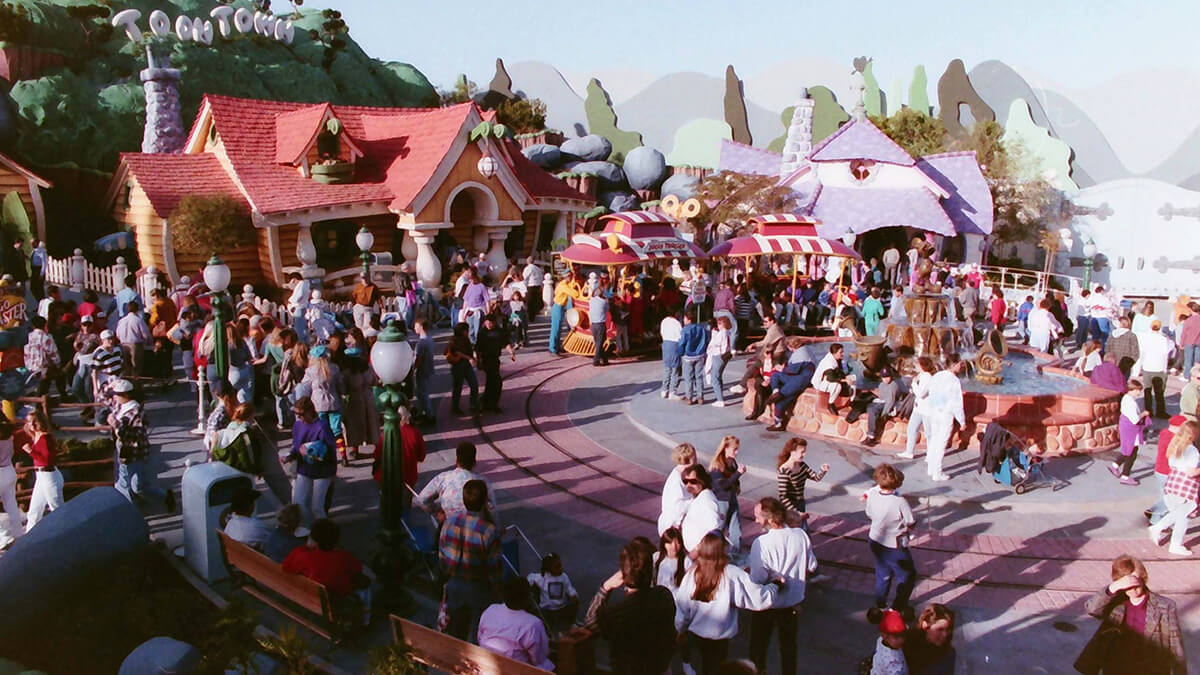
Disneyland in Anaheim, California, holds a special place in the hearts of Disney fans worldwide, I mean heck, it’s where the magic began after all. Over the years it’s become a place that people visit in search of memorable experiences. One fan favorite area of the park is Mickey’s Toontown, a unique land that lets guests step right into the colorful, “Toony” world of Disney animation. With the recent reimagining of the land and the introduction of Micky and Minnies Runaway Railway, have you ever wondered how this land came to be?
There is a fascinating backstory of how Mickey’s Toontown came into existence. It’s a tale of strategic vision, the influence of Disney executives, and a commitment to meeting the needs of Disney’s valued guests.
The Beginning: Mickey’s Birthdayland
The story of Mickey’s Toontown starts with Mickey’s Birthdayland at Walt Disney World’s Magic Kingdom. Opened in 1988 to celebrate Mickey Mouse’s 60th birthday, this temporary attraction was met with such overwhelming popularity that it inspired Disney executives to think bigger. The idea was to create a permanent, immersive land where guests could step into the animated world of Mickey Mouse and his friends.
In the early ’90s, Disneyland was in need of a refresh. Michael Eisner, the visionary leader of The Walt Disney Company at the time, had an audacious idea: create a brand-new land in Disneyland that would celebrate Disney characters in a whole new way. This was the birth of Mickey’s Toontown.
Initially, Disney’s creative minds toyed with various concepts, including the idea of crafting a 100-Acre Woods or a land inspired by the Muppets. However, the turning point came when they considered the success of “Who Framed Roger Rabbit.” This film’s popularity and the desire to capitalize on contemporary trends set the stage for Toontown’s creation.
From Concept to Reality: The Birth of Toontown
In 1993, Mickey’s Toontown opened its gates at Disneyland, marking the first time in Disney Park history where guests could experience a fully realized, three-dimensional world of animation. This new land was not just a collection of attractions but a living, breathing community where Disney characters “lived,” worked, and played.
Building Challenges: Innovative Solutions
The design of Mickey’s Toontown broke new ground in theme park aesthetics. Imagineers were tasked with bringing the two-dimensional world of cartoons into a three-dimensional space. This led to the creation of over 2000 custom-built props and structures that embodied the ‘squash and stretch’ principle of animation, giving Toontown its distinctiveness.
And then there was also the challenge of hiding the Team Disney Anaheim building, which bore a striking resemblance to a giant hotdog. The Imagineers had to think creatively, using balloon tests and imaginative landscaping to seamlessly integrate Toontown into the larger park.

Key Attractions: Bringing Animation to Life
Mickey’s Toontown featured several groundbreaking attractions. “Roger Rabbit’s Car Toon Spin,” inspired by the movie “Who Framed Roger Rabbit,” became a staple of Toontown, offering an innovative ride experience. Gadget’s Go-Coaster, though initially conceived as a Rescue Rangers-themed ride, became a hit with younger visitors, proving that innovative design could create memorable experiences for all ages.
Another crown jewel of Toontown is Mickey’s House, a walkthrough attraction that allowed guests to explore the home of Mickey Mouse himself. This attraction was more than just a house; it was a carefully crafted piece of Disney lore. The house was designed in the American Craftsman style, reflecting the era when Mickey would have theoretically purchased his first home in Hollywood. The attention to detail was meticulous, with over 2000 hand-crafted, custom-built props, ensuring that every corner of the house was brimming with character and charm. Interestingly, the design of Mickey’s House was inspired by a real home in Wichita Falls, making it a unique blend of real-world inspiration and Disney magic.
Mickey’s House also showcased Disney’s commitment to creating interactive and engaging experiences. Guests could make themselves at home, sitting in Mickey’s chair, listening to the radio, and exploring the many mementos and references to Mickey’s animated adventures throughout the years. This approach to attraction design – where storytelling and interactivity merged seamlessly – was a defining characteristic of ToonTown’s success.

Executive Decisions: Shaping ToonTown’s Unique Attractions
The development of Mickey’s Toontown wasn’t just about creative imagination; it was significantly influenced by strategic decisions from Disney executives. One notable input came from Jeffrey Katzenberg, who suggested incorporating a Rescue Rangers-themed ride. This idea was a reflection of the broader Disney strategy to integrate popular contemporary characters and themes into the park, ensuring that the attractions remained relevant and engaging for visitors.
In addition to Katzenberg’s influence, Frank Wells, the then-President of The Walt Disney Company, played a key role in the strategic launch of Toontown’s attractions. His decision to delay the opening of “Roger Rabbit’s Car Toon Spin” until a year after Toontown’s debut was a calculated move. It was designed to maintain public interest in the park by offering new experiences over time, thereby giving guests more reasons to return to Disneyland.
These executive decisions highlight the careful planning and foresight that went into making Toontown a dynamic and continuously appealing part of Disneyland. By integrating current trends and strategically planning the rollout of attractions, Disney executives ensured that Toontown would not only capture the hearts of visitors upon its opening but would continue to draw them back for new experiences in the years to follow.
Global Influence: Toontown’s Worldwide Appeal
The concept of Mickey’s Toontown resonated so strongly that it was replicated at Tokyo Disneyland and influenced elements in Disneyland Paris and Hong Kong Disneyland. Each park’s version of Toontown maintained the core essence of the original while adapting to its cultural and logistical environment.
Evolution and Reimagining: Toontown Today
As we approach the present day, Mickey’s Toontown has recently undergone a significant reimagining to welcome “Mickey & Minnie’s Runaway Railway” in 2023. This refurbishment aimed to enhance the land’s interactivity and appeal to a new generation of Disney fans, all while retaining the charm that has made ToonTown a beloved destination for nearly three decades.

Dive Deeper into ToonTown’s Story
Want to know more about Mickey’s Toontown and hear some fascinating behind-the-scenes stories, then check out the latest episode of Disney Unpacked on Patreon @JimHillMedia. In this episode, the main Imagineer who worked on the Toontown project shares lots of interesting stories and details that you can’t find anywhere else. It’s full of great information and fun facts, so be sure to give it a listen!
History
Unpacking the History of the Pixar Place Hotel

Pixar Place Hotel, the newly unveiled 15-story tower at the Disneyland Resort, has been making waves in the Disney community. With its unique Pixar-themed design, it promises to be a favorite among visitors.
However, before we delve into this exciting addition to the Disneyland Resort, let’s take a look at the fascinating history of this remarkable hotel.
The Emergence of the Disneyland Hotel
To truly appreciate the story of the Pixar Place Hotel, we must turn back the clock to the early days of Disneyland. While Walt Disney had the visionary ideas and funding to create the iconic theme park, he faced a challenge when it came to providing accommodations for the park’s visitors. This is where his friend Jack Wrather enters the picture.
Jack Wrather, a fellow pioneer in the television industry, stepped in to assist Walt Disney in realizing his dream. Thanks to the success of the “Lassie” TV show produced by Wrather’s company, he had the financial means to build a hotel right across from Disneyland.
The result was the Disneyland Hotel, which opened its doors in October 1955. Interestingly, the early incarnation of this hotel had more of a motel feel than a hotel, with two-story buildings reminiscent of the roadside motels popular during the 1950s. The initial Disneyland Hotel consisted of modest structures that catered to visitors looking for affordable lodging close to the park. While the rooms were basic, it marked the beginning of something extraordinary.
The Evolution: From Emerald of Anaheim to Paradise Pier
As Disneyland’s popularity continued to soar, so did the demand for expansion and improved accommodations. In 1962, the addition of an 11-story tower transformed the Disneyland Hotel, marking a significant transition from a motel to a full-fledged hotel.
The addition of the 11-story tower elevated the Disneyland Hotel into a more prominent presence on the Anaheim skyline. At the time, it was the tallest structure in all of Orange County. The hotel’s prime location across from Disneyland made it an ideal choice for visitors. With the introduction of the monorail linking the park and the hotel, accessibility became even more convenient. Unique features like the Japanese-themed reflecting pools added to the hotel’s charm, reflecting a cultural influence that extended beyond Disney’s borders.
Japanese Tourism and Its Impact
During the 1960s and 1970s, Disneyland was attracting visitors from all corners of the world, including Japan. A significant number of Japanese tourists flocked to Anaheim to experience Walt Disney’s creation. To cater to this growing market, it wasn’t just the Disneyland Hotel that aimed to capture the attention of Japanese tourists. The Japanese Village in Buena Park, inspired by a similar attraction in Nara, Japan, was another significant spot.
These attractions sought to provide a taste of Japanese culture and hospitality, showcasing elements like tea ceremonies and beautiful ponds with rare carp and black swans. However, the Japanese Village closed its doors in 1975, likely due to the highly competitive nature of the Southern California tourist market.
The Emergence of the Emerald of Anaheim
With the surge in Japanese tourism, an opportunity arose—the construction of the Emerald of Anaheim, later known as the Disneyland Pacific Hotel. In May 1984, this 15-story hotel opened its doors.
What made the Emerald unique was its ownership. It was built not by The Walt Disney Company or the Oriental Land Company (which operated Tokyo Disneyland) but by the Tokyu Group. This group of Japanese businessmen already had a pair of hotels in Hawaii and saw potential in Anaheim’s proximity to Disneyland. Thus, they decided to embark on this new venture, specifically designed to cater to Japanese tourists looking to experience Southern California.
Financial Challenges and a Changing Landscape
The late 1980s brought about two significant financial crises in Japan—the crash of the NIKKEI stock market and the collapse of the Japanese real estate market. These crises had far-reaching effects, causing Japanese tourists to postpone or cancel their trips to the United States. As a result, reservations at the Emerald of Anaheim dwindled.
To adapt to these challenging times, the Tokyu Group merged the Emerald brand with its Pacific hotel chain, attempting to weather the storm. However, the financial turmoil took its toll on the Emerald, and changes were imminent.
The Transition to the Disneyland Pacific Hotel
In 1995, The Walt Disney Company took a significant step by purchasing the hotel formerly known as the Emerald of Anaheim for $35 million. This acquisition marked a change in the hotel’s fortunes. With Disney now in control, the hotel underwent a name change, becoming the Disneyland Pacific Hotel.
Transformation to Paradise Pier
The next phase of transformation occurred when Disney decided to rebrand the hotel as Paradise Pier Hotel. This decision aligned with Disney’s broader vision for the Disneyland Resort.
While the structural changes were limited, the hotel underwent a significant cosmetic makeover. Its exterior was painted to complement the color scheme of Paradise Pier, and wave-shaped crenellations adorned the rooftop, creating an illusion of seaside charm. This transformation was Disney’s attempt to seamlessly integrate the hotel into the Paradise Pier theme of Disney’s California Adventure Park.
Looking Beyond Paradise Pier: The Shift to Pixar Place
In 2018, Disneyland Resort rebranded Paradise Pier as Pixar Pier, a thematic area dedicated to celebrating the beloved characters and stories from Pixar Animation Studios. As a part of this transition, it became evident that the hotel formally known as the Disneyland Pacific Hotel could no longer maintain its Paradise Pier theme.
With Pixar Pier in full swing and two successful Pixar-themed hotels (Toy Story Hotels in Shanghai Disneyland and Tokyo Disneyland), Disney decided to embark on a new venture—a hotel that would celebrate the vast world of Pixar. The result is Pixar Place Hotel, a 15-story tower that embraces the characters and stories from multiple Pixar movies and shorts. This fully Pixar-themed hotel is a first of its kind in the United States.
The Future of Pixar Place and Disneyland Resort
As we look ahead to the future, the Disneyland Resort continues to evolve. The recent news of a proposed $1.9 billion expansion as part of the Disneyland Forward project indicates that the area surrounding Pixar Place is expected to see further changes. Disneyland’s rich history and innovative spirit continue to shape its destiny.
In conclusion, the history of the Pixar Place Hotel is a testament to the ever-changing landscape of Disneyland Resort. From its humble beginnings as the Disneyland Hotel to its transformation into the fully Pixar-themed Pixar Place Hotel, this establishment has undergone several iterations. As Disneyland Resort continues to grow and adapt, we can only imagine what exciting developments lie ahead for this iconic destination.
If you want to hear more stories about the History of the Pixar Place hotel, check our special edition of Disney Unpacked over on YouTube.
Stay tuned for more updates and developments as we continue to explore the fascinating world of Disney, one story at a time.
History
From Birthday Wishes to Toontown Dreams: How Toontown Came to Be
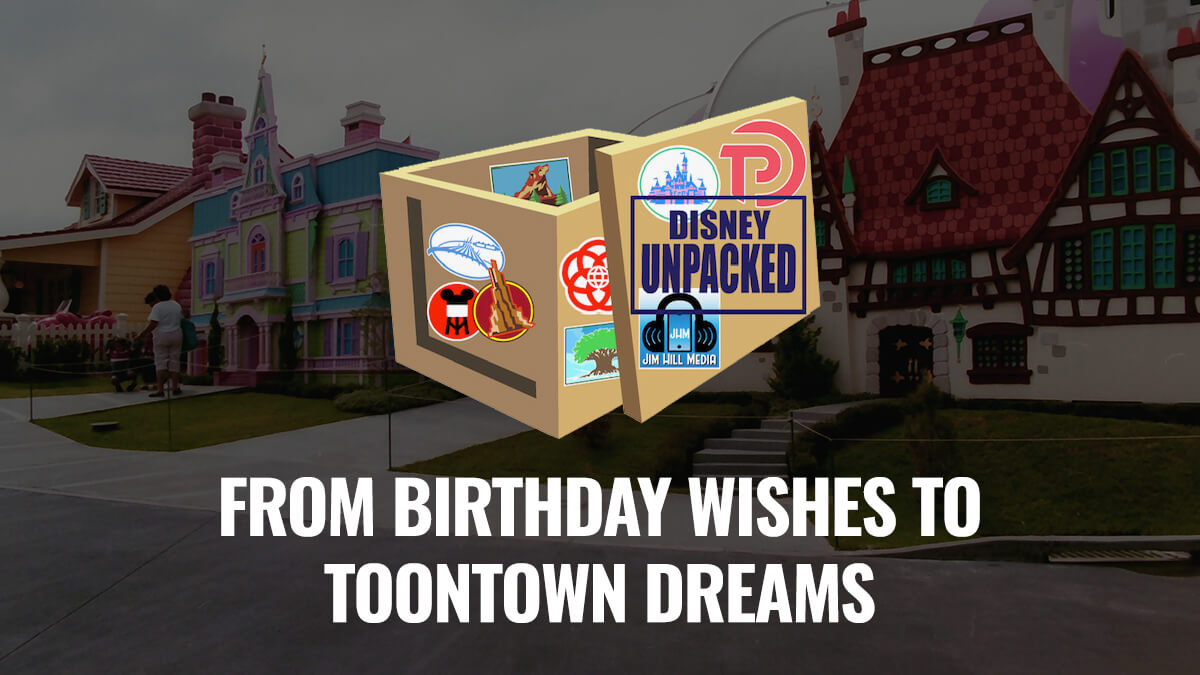
In the latest release of Episode 4 of Disney Unpacked, Len and I return, joined as always by Disney Imagineering legend, Jim Shull. This two-part episode covers all things Mickey’s Birthday Land and how it ultimately led to the inspiration behind Disneyland’s fan-favorite land, “Toontown”. But let’s not get ahead of ourselves here. It all starts in the early days at Disneyland.
Early Challenges in Meeting Mickey
Picture this: it’s the late 1970s and early 1980s, and you’re at Disneyland. You want to meet the one and only Mickey Mouse, but there’s no clear way to make it happen. You rely on Character Guides, those daily printed sheets that point you in Mickey’s general direction. But let’s be honest, it was like finding a needle in a haystack. Sometimes, you got lucky; other times, not so much.

Mickey’s Birthdayland: A Birthday Wish that Came True
Fast forward to the late 1980s. Disney World faced a big challenge. The Disney-MGM Studios Theme Park was under construction, with the company’s marketing machine in full swing, hyping up the opening of Walt Disney World’s third theme park, MGM Studios, in the Spring of 1989. This extensive marketing meant that many people were opting to postpone their family’s next trip to Walt Disney World until the following year. Walt Disney World needed something compelling to motivate guests to visit Florida in 1988, the year before Disney MGM Studios opened.
Enter stage left, Mickey’s Birthdayland. For the first time ever, an entire land was dedicated to a single character – and not just any character, but the mouse who started it all. Meeting Mickey was no longer a game of chance; it was practically guaranteed.

The Birth of Birthdayland: Creative Brilliance Meets Practicality
In this episode, we dissect the birth of Mickey’s Birthdayland, an initiative that went beyond celebrating a birthday. It was a calculated move, driven by guest feedback and a need to address issues dating back to 1971. Imagineers faced the monumental task of designing an experience that honored Mickey while efficiently managing the crowds. This required the perfect blend of creative flair and logistical prowess – a hallmark of Disney’s approach to theme park design.
Evolution: From Birthdayland to Toontown
The success of Mickey’s Birthdayland was a real game-changer, setting the stage for the birth of Toontown – an entire land that elevated character-centric areas to monumental new heights. Toontown wasn’t merely a spot to meet characters; it was an immersive experience that brought Disney animation to life. In the episode, we explore its innovative designs, playful architecture, and how every nook and cranny tells a story.
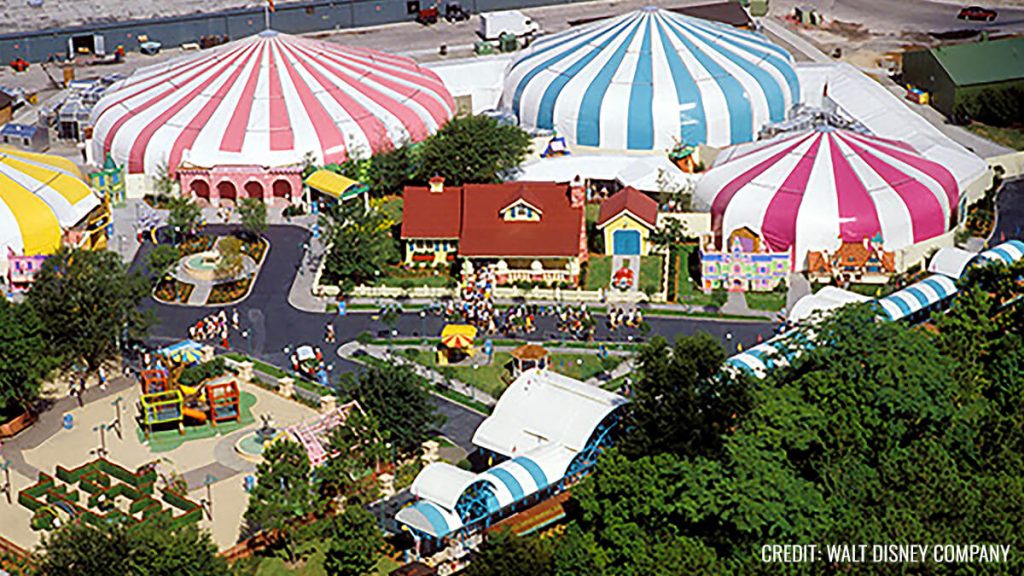
Impact on Disney Parks and Guests
Mickey’s Birthdayland and Toontown didn’t just reshape the physical landscape of Disney parks; they transformed the very essence of the guest experience. These lands introduced groundbreaking ways for visitors to connect with their beloved characters, making their Disney vacations even more unforgettable.
Beyond Attractions: A Cultural Influence
But the influence of these lands goes beyond mere attractions. Our episode delves into how Mickey’s Birthdayland and Toontown left an indelible mark on Disney’s culture, reflecting the company’s relentless dedication to innovation and guest satisfaction. It’s a journey into how a single idea can grow into a cherished cornerstone of the Disney Park experience.

Unwrapping the Full Story of Mickey’s Birthdayland
Our two-part episode of Disney Unpacked is available for your viewing pleasure on our Patreon page. And for those seeking a quicker Disney fix, we’ve got a condensed version waiting for you on our YouTube channel. Thank you for being a part of our Disney Unpacked community. Stay tuned for more episodes as we continue to “Unpack” the fascinating world of Disney, one story at a time.
-

 News & Press Releases11 months ago
News & Press Releases11 months agoDisney Will Bring D23: The Ultimate Disney Fan Event to Anaheim, California in August 2024
-
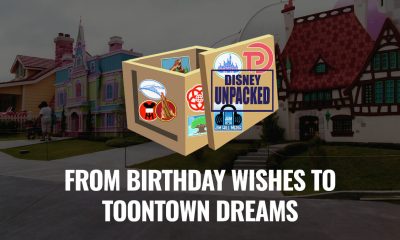
 History6 months ago
History6 months agoFrom Birthday Wishes to Toontown Dreams: How Toontown Came to Be
-

 History6 months ago
History6 months agoUnpacking the History of the Pixar Place Hotel
-

 History6 months ago
History6 months agoThe Evolution and History of Mickey’s ToonTown
-

 News & Press Releases5 months ago
News & Press Releases5 months agoNew Updates and Exclusive Content from Jim Hill Media: Disney, Universal, and More
-
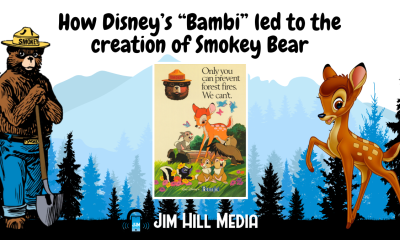
 Film & Movies3 months ago
Film & Movies3 months agoHow Disney’s “Bambi” led to the creation of Smokey Bear
-

 Merchandise4 months ago
Merchandise4 months agoIntroducing “I Want That Too” – The Ultimate Disney Merchandise Podcast






